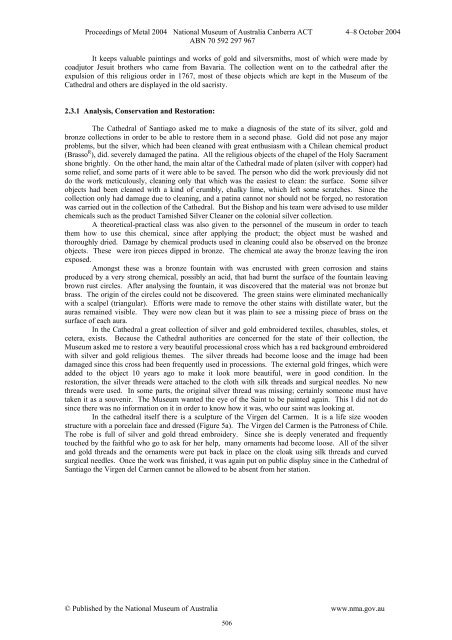Section 4: Composite artefacts (PDF 20858kb) - National Museum of ...
Section 4: Composite artefacts (PDF 20858kb) - National Museum of ...
Section 4: Composite artefacts (PDF 20858kb) - National Museum of ...
- No tags were found...
Create successful ePaper yourself
Turn your PDF publications into a flip-book with our unique Google optimized e-Paper software.
Proceedings <strong>of</strong> Metal 2004 <strong>National</strong> <strong>Museum</strong> <strong>of</strong> Australia Canberra ACT 4–8 October 2004ABN 70 592 297 967It keeps valuable paintings and works <strong>of</strong> gold and silversmiths, most <strong>of</strong> which were made bycoadjutor Jesuit brothers who came from Bavaria. The collection went on to the cathedral after theexpulsion <strong>of</strong> this religious order in 1767, most <strong>of</strong> these objects which are kept in the <strong>Museum</strong> <strong>of</strong> theCathedral and others are displayed in the old sacristy.2.3.1 Analysis, Conservation and Restoration:The Cathedral <strong>of</strong> Santiago asked me to make a diagnosis <strong>of</strong> the state <strong>of</strong> its silver, gold andbronze collections in order to be able to restore them in a second phase. Gold did not pose any majorproblems, but the silver, which had been cleaned with great enthusiasm with a Chilean chemical product(Brasso R ), did. severely damaged the patina. All the religious objects <strong>of</strong> the chapel <strong>of</strong> the Holy Sacramentshone brightly. On the other hand, the main altar <strong>of</strong> the Cathedral made <strong>of</strong> platen (silver with copper) hadsome relief, and some parts <strong>of</strong> it were able to be saved. The person who did the work previously did notdo the work meticulously, cleaning only that which was the easiest to clean: the surface. Some silverobjects had been cleaned with a kind <strong>of</strong> crumbly, chalky lime, which left some scratches. Since thecollection only had damage due to cleaning, and a patina cannot nor should not be forged, no restorationwas carried out in the collection <strong>of</strong> the Cathedral. But the Bishop and his team were advised to use milderchemicals such as the product Tarnished Silver Cleaner on the colonial silver collection.A theoretical-practical class was also given to the personnel <strong>of</strong> the museum in order to teachthem how to use this chemical, since after applying the product; the object must be washed andthoroughly dried. Damage by chemical products used in cleaning could also be observed on the bronzeobjects. These were iron pieces dipped in bronze. The chemical ate away the bronze leaving the ironexposed.Amongst these was a bronze fountain with was encrusted with green corrosion and stainsproduced by a very strong chemical, possibly an acid, that had burnt the surface <strong>of</strong> the fountain leavingbrown rust circles. After analysing the fountain, it was discovered that the material was not bronze butbrass. The origin <strong>of</strong> the circles could not be discovered. The green stains were eliminated mechanicallywith a scalpel (triangular). Efforts were made to remove the other stains with distillate water, but theauras remained visible. They were now clean but it was plain to see a missing piece <strong>of</strong> brass on thesurface <strong>of</strong> each aura.In the Cathedral a great collection <strong>of</strong> silver and gold embroidered textiles, chasubles, stoles, etcetera, exists. Because the Cathedral authorities are concerned for the state <strong>of</strong> their collection, the<strong>Museum</strong> asked me to restore a very beautiful processional cross which has a red background embroideredwith silver and gold religious themes. The silver threads had become loose and the image had beendamaged since this cross had been frequently used in processions. The external gold fringes, which wereadded to the object 10 years ago to make it look more beautiful, were in good condition. In therestoration, the silver threads were attached to the cloth with silk threads and surgical needles. No newthreads were used. In some parts, the original silver thread was missing; certainly someone must havetaken it as a souvenir. The <strong>Museum</strong> wanted the eye <strong>of</strong> the Saint to be painted again. This I did not dosince there was no information on it in order to know how it was, who our saint was looking at.In the cathedral itself there is a sculpture <strong>of</strong> the Virgen del Carmen. It is a life size woodenstructure with a porcelain face and dressed (Figure 5a). The Virgen del Carmen is the Patroness <strong>of</strong> Chile.The robe is full <strong>of</strong> silver and gold thread embroidery. Since she is deeply venerated and frequentlytouched by the faithful who go to ask for her help, many ornaments had become loose. All <strong>of</strong> the silverand gold threads and the ornaments were put back in place on the cloak using silk threads and curvedsurgical needles. Once the work was finished, it was again put on public display since in the Cathedral <strong>of</strong>Santiago the Virgen del Carmen cannot be allowed to be absent from her station.© Published by the <strong>National</strong> <strong>Museum</strong> <strong>of</strong> Australia www.nma.gov.au506
















